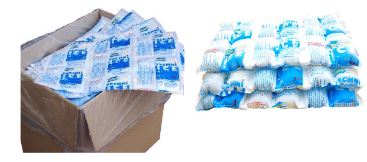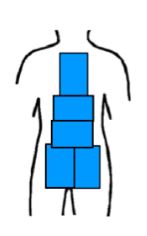Introduction
Definition of terms
Assessment
Preparation of the Techniice sheets
Management
Disposing of the Techniice
Documentation
Family Centred Care
Companion Documents
Evidence Table
Introduction
The importance for bereaved families to be
offered the opportunity to spend time with their child after death, in hospital
and at home, is well described in literature. Previously the hurdles of environmental
needs to maintain the integrity of the child’s body have limited the
opportunity to provide this extended service to families of children older than
one. Information on the other cooling options, such as Very Special Kids, which
offers a Cool Room, and the use of the Cuddle Cot, a cooling mattress that can
fit an infant, can be found on the Death of a Child CPG.
Techniice is a portable, disposable, cooling
system that allows any family who wish to spend extended time with their child
after death.
The aim of this guideline is to provide nursing,
allied health and medical staff with an overview of the use and management of
Techniice during after death care at the Royal Children’s Hospital, Melbourne.
Definition of terms
- Techniice
– A disposable
sheet made of refrigerant polymer and high-density plastic, which is non-toxic,
and can be frozen to provide optimal cooling for a deceased body
Assessment
Techniice is a single use disposable sheet made
of high-density plastic and refrigerant polymer which is non-toxic. The thin
flat sheets can be hydrated with water through a one-way perforation technology
that allows water to be absorbed but not leak out. Once frozen the refrigerant
polymer will maintain temperatures under –18oC, which means when rotating the
product as needed, it can be used to keep a body cool for several days post
death, allowing time for a family to spend time with their baby, child or teen.
Techniice is suitable for consideration:
- In the circumstance where staff are waiting for family
to be in attendance post death
- Where there is expected to be a delay of 4 hours
post death before the child is placed in the mortuary/be collected by Funeral
Directors
- Where family wish to spend extended time with
the child after death (in hospital or at home)
The benefit of Techniice:
- No
age or size limitations (each cell can handle 30kg weight)
- Portable
which allows families to choose where their child is placed (arms, cot, bed,
pram etc).
- Available
to all families, including supporting regional services
- Reusable
in the home setting (single patient use)
- Minimal
perspiration from cells (to allow optimal care of the body and reduce distress
for family)
- No
need to arrange drop off equipment after use
Preparation of
the Techniice sheets
Preparation
involves two steps: hydration and freezing.
Consider the size
of the child you are making the Techniice for prior to hydrating the sheets.
Each Techniice sheet comes with 24 cells. In the case of a smaller neonate, or
smaller sections of the child (such as under the neck) it is best to cut the
sheets into the required size prior to hydrating them.
Below are the
recommended number of sheets needed (they do not need to be cut into individual
squares):
- Preterm
Neonate: Quarter to half a sheet
- Infant:
Half to full sheet
- Young
Child: Two to three full sheets
- Teen:
Four to six full sheets
If expecting to
keep the body cool for several days, prepare and freeze double the number of
sheets required to allow for rotation as needed.
It is safe to
hydrate and freeze several precut sizes, to ensure some appropriately sized
sheets are always available. The purpose bought freezer located in the RCH Body
Hold will always have the following available:
- 10 x Neck sheets (2 cells)
- 10 x Quarter sheets
- 20 x Half sheets
- 20 x Full sheets
Hydration:
Techniice comes
as dehydrated sheets which must be fully submerged into water prior to
freezing.
An instructional
video on this following process above can be found here (How to Hydrate Techniice Dry Ice Packs
Sheets)
You will need:
Techniice sheets, access to water, sink or bath and large dry towel
- Fully submerge required number of Techniice
sheets into a sink/bath of water (the warmer the water the quicker the
absorption process)
- Whilst
submerged, scrunch the sheet, massaging each cell between your fingers. Air
bubbles will come out as water enters each cell – this is normal.
- If
not already, flatten sheets out in the water to allow optimal uptake into each
cell
- If
there are any cells that have not inflated, continue to massage these to help
activation
- Continue the above process for approximately 3-5
minutes until each cell has swelled. At peak they will become approximately 2cm
in width.
- Once all cells are fully inflated, remove the
sheets and place them on a dry towel.
- Carefully and thoroughly pat the sheets
dry – this is very important as any residual water on the outside will turn to
ice and cause the dampness

Image 1: Prior and after hydration (curtesy of
techniice.com)
Freezing:
Techniice needs
to be placed into the freezer flat with plastic side down. Separate sheets with
a provided reusable silicone mat between each sheet to ensure the sheets do not
stick to each other. Do not use cling wrap between sheets as these will stick
to the sheets as they freeze and compromise the integrity of the product.
Sheets must
remain in the freezer for a minimum of 24 hours for best results.
Once frozen they
are ready for use.
Management
It is important
to talk through the purpose of the Techniice with the family in a sensitive
manner. The coolness of the sheets and subsequent cooling of the child can be
distressing to family if they have not had the purpose of its use explained.
Ideally Techniice
is placed to assist cooling as soon after death as appropriate. It is not
compulsory but, in the circumstance, where it is expected that a child will not
be transferred to the mortuary or picked up within 4 hours post death the use
of Techniice will optimise the integrity of the body.
The frozen
Techniice should not be placed directly to or under the body as it will damage
the skin. It must be placed in a single thickness sheet (this can be either a
hospital sheet or the family's own linen.
It is only required
with initial cooling to place Techniice ice:
- Behind head and neck
- Over the abdomen of an older child or teen (this
is commonly where odours arise from and the area which takes the longest to
cool after death. Therefore, application immediately after death is important
and may require 4 hourly rotations initially)
The other key
locations that should always have Techniice are:
- Behind the back including between the shoulder
blades
- Across the lower back/kidneys

Image 2.
Suggested sheet placement on an older child courtesy of Queensland Health
(2021).
Each sheet will
commonly last at least 8-10 hours, though may need replacing earlier if noted
to be warming up (they will feel soft and warm to touch). Environmental
factors, such as cuddling, or the ambience of the room may hasten defrosting of
the cells. In this case, the sheets may be rotated earlier.
When rotating the
Techniice sheets, remove the prefrozen second set from the freezer, lift the
child, or roll the child gently to their side and replace the defrosted sheets
with the new frozen replacements, ensuring they are not placed directly onto
the skin.
In the hospital
setting the previous sheets must be discarded – do not place them back in the
freezer, even if the intent is for the same patient. In the home setting the
family may place them back in their home freezer to re-freeze. There is no need
to repeat the hydration steps, the family can simply wipe the sheets down with
a dry tea towel/cloth and place back in the freezer. Continue to rotate the
sheets until after death care is no longer required (I.e the child is placed in
the mortuary or collected by a funeral director).
Possible
Complications:
- Condensation: Any wetness from the product will
be due to incomplete drying prior to the freezing process. To reduce this risk,
the Techniice may be placed in a thin plastic zip lock bag prior to being
covered with the chosen linen.
- Tear in a cell: If this were to occur, though
extremely unlikely, the product may be discarded following the usual disposable
process described below. The internal product is non-toxic; usual hand washing
with soap and water suffices.
Disposing of
the Techniice
The contents of Techniice are
non-toxic and safe to dispose in the normal waste in hospital and the household
waste bin in a community setting, the product itself is designed to breakdown
after long exposure to UV light. Techniice also offers a free recycling service
at their Frankston outlet. In the circumstance where the child is under contact
precautions, such as cytotoxic or droplet infection control, and there is
concern the sheets have had contact with the child, then the product should be
discarded in a provided hazardous or cytotoxic waste bin.
Documentation
Please note in
the Death Checklist, under subtitle: Destination of Body, if the product has
been used.
Family Centred
Care:
- Where
feasible verbal consent for the use of the product should be sought prior to
use
- Family
should be advised that they may continue to care and handle their child as they
wish, including washing and bathing them, however handling may increase the
rate of compromise of the child’s body. Techniice cannot remove this risk but
will help stabilize the overall integrity
- Sensitive
education should still be provided on the expected physiological changes that
occur to a deceased body over time (ie. Colour changes, odour, leakage of body
fluids, stiffing of limbs). Reassurance that these processes are expected and
may be minimised, but not avoided, with the correct use of Techniice
- It
is important to ensure families who are taking their child home have a Hospital
Contact if they have any concerns or questions. This should be the contact
phone number to the ward the patient has come from.
Companion documents
Death of a Child
CPG
Use of Bereavement
Facilities Policy and Procedure
Special thanks to Paediatric Palliative Care
Service, Queensland for their advice and support in the development of this
guideline.
Evidence table
The evidence table for this guideline can be accessed here.
Please remember to read the disclaimer.
The development
of this nursing guideline was coordinated by Melissa Heywood, CNC, Victorian
Paediatric Palliative Care Program, Jess Rowe, RN, Rosella, and Gemma Sutton,
RN, Butterfly, and approved by the Nursing Clinical Effectiveness Committee. First published June 2022.